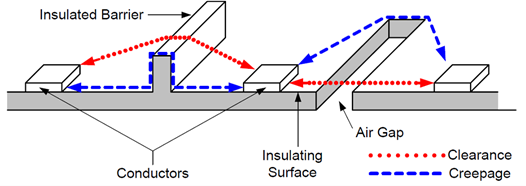
Clearance and creepage distances are essential considerations in designing bus bar systems, as they play a vital role in ensuring safety, reliability, and operational efficiency. This article provides a brief explanation of their significance and the possible faults that may arise if these distances have not adhered to standard specifications.
Importance of Clearance and Creepage Distance
- Electrical Insulation and Safety:
Clearance Distance: This is the shortest distance through the air between two conductive parts or between a conductive part and a non-conductive surface. It prevents electrical arcing and breakdown between these parts. Proper clearance ensures that even under high voltages, there’s enough space to avoid accidental conduction.
Creepage Distance: This is the shortest distance along the surface of an insulating material between two conductive parts. It prevents surface leakage currents from causing short circuits or electrical arcing. Creepage distance is crucial for insulation integrity, especially in environments with high humidity or contamination.
- Prevention of Electrical Failures:
Sufficient clearance and creepage distances are essential in mitigating electrical failures that may arise from arcing, corona discharge, or insulation breakdown. These distances hold particular significance in high-voltage systems, where the likelihood of failure is considerably elevated.
- Compliance with Standards:
Electrical standards, such as IEC 61439, delineate the minimum requirements for clearance and creepage distances to guarantee safety and optimal performance. Adhering to these standards is essential for ensuring dependable operation and mitigating potential legal or regulatory complications.
- Long-Term Reliability:
Maintaining appropriate distances is essential for the durability and dependability of the bus bar system. This practice aids in preventing premature wear or deterioration of insulating materials caused by electrical stresses.
Potential Faults if Standard Values are Not Maintained
- Electrical Arcing:
Insufficient clearance distances may result in electrical arcing occurring between conductors or between a conductor and the ground. Such occurrences can cause damage to equipment, pose fire risks, or potentially lead to system failures.
- Insulation Breakdown:
Inadequate creepage distances can cause the insulation material to fail due to surface leakage currents. This can result in short circuits, equipment malfunction, or electrical shock hazards.
- Short Circuits:
Reduced clearance and creepage distances can lead to unintentional conductive paths between bus bars or other components. This can cause short circuits, causing overheating, equipment damage, or system outages.
- Electrical Discharge:
In settings characterized by significant contamination or humidity, inadequate creepage distances may promote surface discharge. This phenomenon can compromise insulation integrity and elevate the likelihood of electrical failure.
- Reduced System Reliability:
Insufficient distances can lead to frequent maintenance issues and operational interruptions. This can affect the overall reliability and efficiency of the electrical system.
- Increased Maintenance Costs:
Frequent failures or maintenance due to inadequate clearance and creepage distances can increase operational costs. This results in higher maintenance expenses and potential downtime.
- Regulatory Non-Compliance:
Failing to adhere to the specified distances may result in non-compliance with safety regulations. This can lead to legal issues, fines, or the need for costly redesigns and retrofits
Design Considerations
- Material Selection: Use materials with appropriate insulation properties to ensure effective creepage distances.
- Environmental Factors: Consider factors like humidity, pollution, and temperature that might affect creepage distances and insulation performance.
- Voltage Levels: Design clearance and creepage distances according to the operating voltage and the specific requirements of the application.
- Standards and Guidelines: Always refer to relevant industry standards (e.g., IEC 61439) for the required distances based on voltage and environmental conditions.
In conclusion, maintaining standard clearance and creepage distances is essential for the safe and dependable functioning of bus bar systems. This practice mitigates the risk of electrical faults and guarantees optimal performance throughout the system’s expected lifespan.
